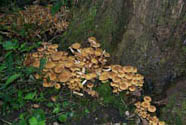 Key to Gilled Mushrooms Key
Key to Gilled Mushrooms KeyThis is a key to gilled mushrooms, that is, mushrooms having a definite cap with a fertile surface consisting of gills. The fruiting body usually also has a stem, although that may be lateral or absent (usually, then, the mushroom is growing from wood). You can use this key to identify mushrooms that you find.
 Agaricales Order
Agaricales OrderFruiting body containing fibers (usually in the stalk)
 White Spored Suborder
White Spored SuborderSpore print "light-colored": white or buff, sometimes tinged with pink or tan. Greenish and (except for the Russulales) yellow spore prints also go here
Stalk fibrous, not fracturing like a piece of chalk
 Tricholomataceae Family
Tricholomataceae FamilyNone of the special features distinguishing the other white-spored genera:
Gills not free, as in the Lepiotas and Amanitas
Basidia not extra-long, as in the Hygrophoraceae
Spores smooth, except for Lentinellus
 Lignicolous Trich Subfamily
Lignicolous Trich SubfamilyGrowing on trees or dead wood, leaves, or sticks, or organic debris, often in moss
 Normal LignoTrich Tribe
Normal LignoTrich TribeShaped like a “normal mushroom”
Small and fragile to medium-sized, except for one large, grey-capped species
Small Ligno Trich SubtribeFruiting body small: cap up to 1 1/4" across (and most clearly smaller than that)
Omphalinoids SemiTribe

Diagnosis
- Mature fruiting body with an omphalos, never bell-shaped or conical. Never even flat except when very young.
-
Usually more colorful than the other choices
-
Often growing in or among a lichen
Comments
Congratulations! You are now officially in mushroom-identification purgatory. There are many genera that mushrooms fitting this diagnosis can be place in, and NOBODY really knows where they should all go. Thus, my diagnoses of genera under this taxon should be considered a matter of "do as little harm as possible" rather than the scientific precision to which you are otherwise accustomed. :-) Basically, I'm just trying to hold down the fort for a while here, until the experts get it thrashed out. I am particularly thrilled that the make-up of our local flora lets me leave out Gerronema altogether, in favor of its segregates Chrysomphalina and Rickenella. And Singer's delimitation of Omphalina by color, while it has turned out to have nothing to do with phylogeny, is a reasonably handy field characteristic
Narrow down your identification:
Chrysomphalina Genus
 Omphalina Genus
Omphalina Genus
 Xeromphalina Genus
Xeromphalina Genus- Stem dark, tough
-
Gills often yellow (sometimes pale) or orange, typically decurrent
-
Revenant
-
Context turns pink to red with KOH






 Key to Gilled Mushrooms Key
Key to Gilled Mushrooms Key Agaricales Order
Agaricales Order White Spored Suborder
White Spored Suborder Tricholomataceae Family
Tricholomataceae Family Lignicolous Trich Subfamily
Lignicolous Trich Subfamily Normal LignoTrich Tribe
Normal LignoTrich Tribe
 Omphalina Genus
Omphalina Genus Xeromphalina Genus
Xeromphalina Genus




